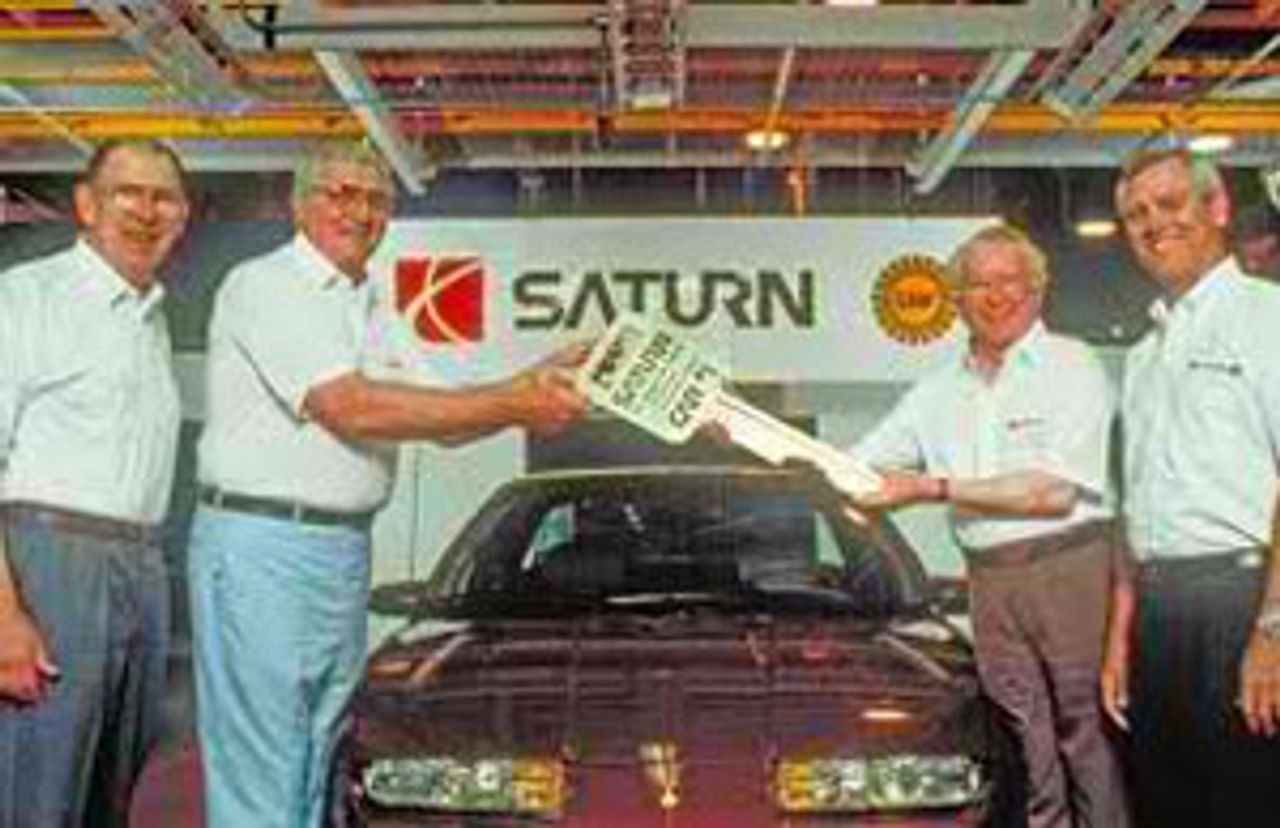This Week in History provides brief synopses of important historical events whose anniversaries fall this week.
25 Years Ago | 50 Years Ago | 75 Years Ago | 100 Years Ago
25 years ago: US autoworkers under attack
 UAW President Owen Bieber and GM President Roger
UAW President Owen Bieber and GM President RogerSmith
This week in 1986, leading US automaker General Motors announced it would close several Michigan plants, throwing tens of thousands of people out of work. Separately it was announced that a United Auto Workers (UAW) union local at a Michigan glassmaker would be banished after the victory of a decertification campaign. The UAW, which then counted hundreds of thousands of members, offered no resistance.
GM did not announce which plants would be shuttered, but Clark Street Fleetwood (6,000 jobs) and the Fisher Guide plant (1,700 jobs) in Detroit, the Central Foundry Division and CPC Assembly (each 1,800 jobs) in Pontiac, and the BOC Flint Body Assembly (3,000 jobs) and Truck and Bus Assembly (3,200 jobs) in Flint were all considered likely targets, part of a broader plan to wipe out as many as 100,000 jobs over the next several years.
The three cities—Detroit, Pontiac, and Flint—had already been devastated by a wave of plant closures and layoffs that began in the late 1970s, part of a far-reaching attack on the American working class and a dramatic shift by the ruling class away from manufacturing and toward increased financial speculation.
The Guardian Glass workers in Carleton, Michigan lost the right to a union in a decertification vote after the corporation filled the plant with strikebreakers. The 360 workers had initiated a months-long strike in the summer against owner Bill Davidson, who refused to negotiate a contract and then set the workers up for decertification by hiring hundreds of strike-breakers.
The UAW offered no resistance to either the union-busting at Guardian or the plans to lay off tens of thousands of the workers it nominally represented. In response to the plant closure plan, union Vice President Donald Ephlin sounded “like a stockholder and middle manager,” the Bulletin newspaper, forerunner of the World Socialist Web Site, noted. “We know GM has lost market share, and we think greater efforts must be made to improve the company’s position and to preserve the jobs of members,” Ephlin said.
The UAW tacitly supported the attack on wages at parts makers like Guardian Glass as a means of making the finished products of the Big Three automakers more competitive. And far from initiating a struggle against job- and wage-cutting, the UAW was funneling money to Democratic Party politicians, including Michigan Gov. James Blanchard, who was also receiving major financial backing from none other than Davidson.
50 years ago: Paris police massacre French Muslims
 Memorial plaque to victims of Paris
Memorial plaque to victims of Parispolice riot
On October 17, 1961, Paris police acting on the orders of Police Chief Maurice Papon opened fired on peaceful demonstrations involving 30,000 French Muslims. At least 80 were killed. Some were shot, others were thrown alive over bridges into the Seine, and another 68 were “disappeared.” About 11,600 were arrested and herded into stadiums on the outskirts of the city.
The demonstrations, carried out by Arabs who were overwhelmingly French citizens, were called to support the struggle for Algerian independence and against an October 5 police curfew against all Algerian Muslim workers and French Muslims, including Tunisians and Moroccans. The Algerian war of independence, then in its eighth year, had cost the lives of tens of thousands of Algerians and thousands of French settlers and soldiers. It had provoked crisis after crisis in the French ruling class, giving rise to militarist plots against the French Republic.
One veteran of the war against Algeria who had been involved in the use of torture, killing and other forms of exemplary punishment was none other than Papon, who had been prefect of an Algerian department until his appointment as French police chief in 1958. In that post he headed up a police force heavily populated by veterans of the Algerian and Vietnamese wars and rightist officers who had served as collaborators during the Nazi occupation of France.
The French authorities refused to admit the horrific crime until the information came out when Papon was put on trial in 1998 for his role in the deportation of thousands of French Jews to Nazi extermination camps during World War II.
75 years ago: Hitler signs militarist Four-Year Plan
 German tanks in operation in Greece, 1941
German tanks in operation in Greece, 1941On October 18, 1936, Adolph Hitler signed a decree in Berchtesgarten placing the Nazi Four-Year Plan for rearmament solely in the hands of General Hermann Göring, who was empowered to issue executive orders to carry through the rapid militarization program.
Hitler had become convinced that it was no longer possible to reconcile growing domestic consumption and rearmament. In the words of historian Ian Kershaw, “priorities had been established… Through the introduction of the Four-Year Plan, Germany was economically pushed in the direction of expansion and war.”
In the words of a contemporary newspaper account, militarization “is now to be intensified until German industry is working under conditions which are normally considered justified only in time of war.”
There had been controversy prior to the plan’s adoption. According to a report in the Times of London, sections of German business and industry connected to consumer and export markets were unsatisfied with the direction of German industrial production under the plan. They wished to retreat from armament production and for Germany to reenter international markets. Their business interests were represented in the upper circles of the Nazi regime by Economic Minister Hjalmar Schacht. But the Times noted that Schacht’s career and influence were declining in tandem with the business interests he represented.
The Times argued that Göring was ideally suited to discipline any dissenting voices in the Nazi trade union, the National Labor Front. Attempting to dampen worker disquiet, the Nazi newspaper established by Göbbels, Der Angriff, claimed that the plan abolished status differences between German employers and employees. “All Labor comrades have now the proud knowledge that they no longer work to make profits for industrialists but for the strengthening of the German national economy,” it wrote.
100 years ago: Amundsen begins expedition to South Pole
 Amundsen at the South Pole
Amundsen at the South PoleOn October 20, 1911, Norwegian explorer Roald Amundsen and four others, together with 52 Greenland huskies and four sleds, left their base in Antarctica to begin their bid to be the first explorers to reach the South Pole. A British team led by Robert Falcon Scott was making a similar attempt, though via a different route devised by British explorer Ernest Shackleton.
Amundsen’s team included a naval gunner, a skiing champion and two expert dog drivers. He counted on this expertise to have the edge against the much larger British expedition, which utilized motorized sledges and Manchurian ponies, but which could not organize its dogs into disciplined teams.
The transformation of the endeavor into a race was bound up with national tensions. Norway had become a separate state only in 1905. Although its large merchant navy shipped many British goods, there were numerous incidents involving British fishing trawlers trespassing remote Norwegian waters.
Amundsen had waited anxiously for a break in the winter blizzards. The previous summer he had established supply depots down to 82 degrees south, considerably further south than Scott. He had already made a false start in September that nearly ended in disaster. On December 14-15, Amundsen reached the South Pole itself and planted the Norwegian flag. He and his team returned safely, with 11 dogs and two sledges left, having covered 1,800 nautical miles in 99 days.
The achievement was internationally announced on March 7, 1912, when Amundsen arrived at Hobart. The “race” had been the occasion for patriotic fervor. The London Times editorialized that Amundsen had not “played the game” in keeping his bid secret from Scott as long as possible. The New York Times noted that the success of Amundsen occasioned an “orgy of Anglophobism” in Berlin.
Scott and his southern team reached the South Pole 33 days after Amundsen. Tragically, on their return journey all five perished, trapped by a blizzard only 11 miles from their southernmost depot.
